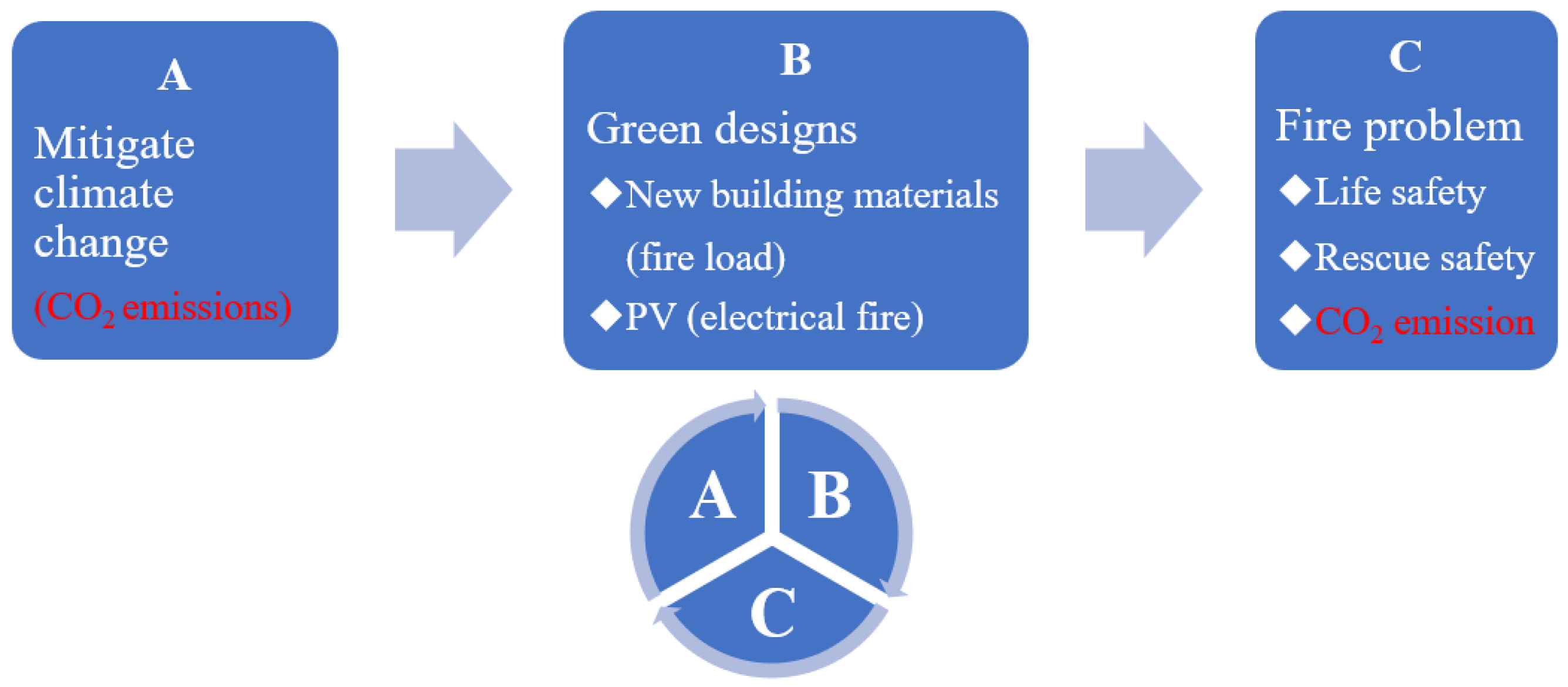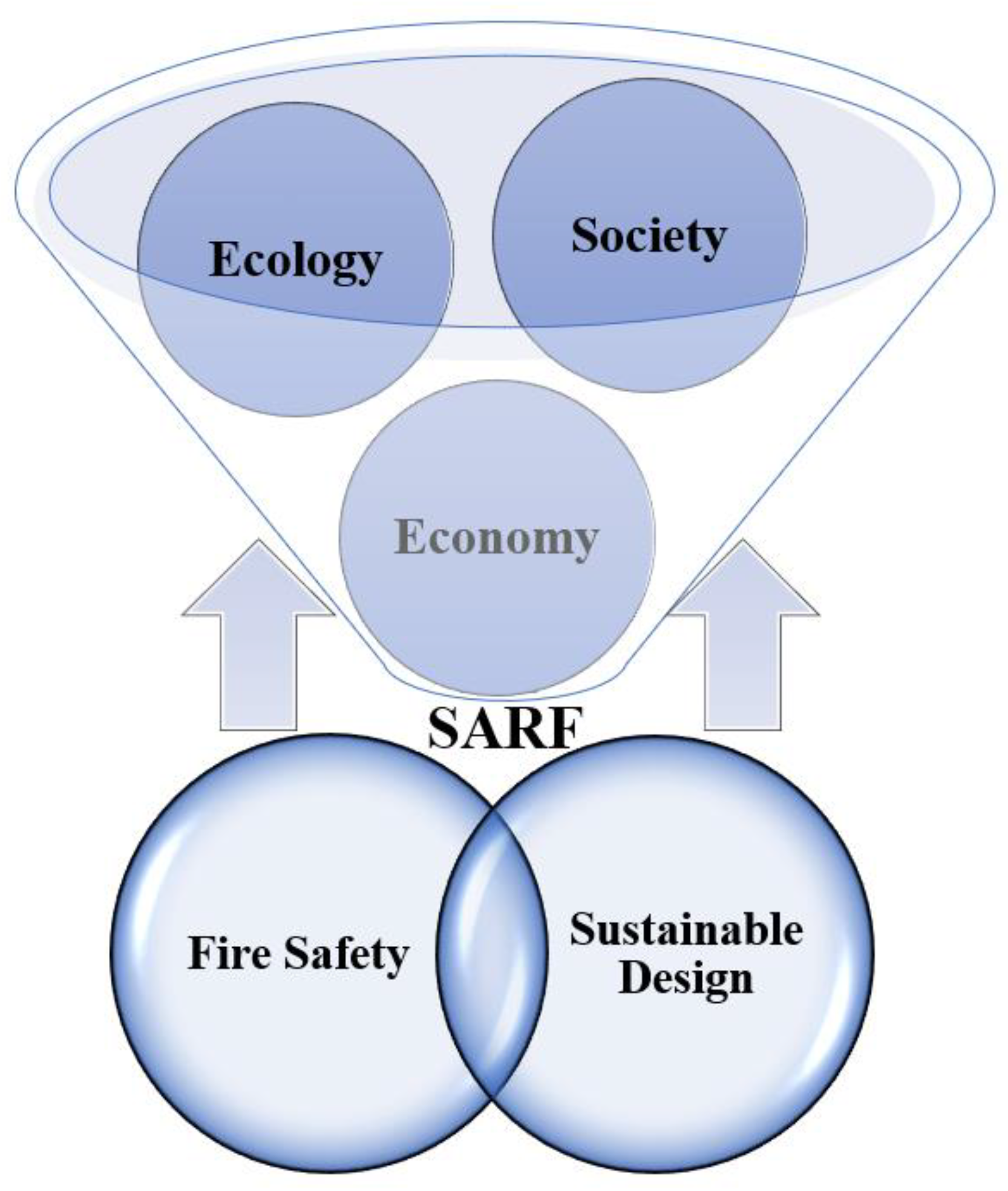An Article on Green Firefighting Equipment in Taiwan
Abstract
:1. Introduction
2. Problem Discussion
2.1. Fire Casualties and Losses
2.2. Are Greening Technology against Fire Safety?
3. Fire and the Greenhouse Effect
3.1. Green Building Materials and Fire Performance
3.2. Climate Change Increased Fire Risks?
3.3. Can Sustainable Construction Be Combined with Fire Safety: Take Sprinkler and Fire Alert as an Example
3.4. Summary: Green (Green Design) and Red (Fire Safety) Interference
4. Changes in Fire Hazards Factors
4.1. Classification of Fire Hazard Factors
- Population growth, aging and obesity: Inability to evacuate in time in the event of a fire increases the risk of fire.
- The wealth gap: An increase in the gap between the rich and the poor will also increase the fire safety gap. It is the foundation of fertile ground for international instability and unequal development.
- Cyber attacks: Cyber attacks on critical security systems can be used to cause fires and explosions.
- Climate change: It is directly related to the risk of global wildfires and has a significant impact on the wildland-urban interface (WUI).
- Urbanization: The rapid population growth and concentration, and the increase in building density have led to an increase in the number of fires and casualties.
4.2. Resilience
4.3. The Trend of Combining Architecture, Fire Protection and Other Disciplines
4.4. Thermal Insulation Is not Equal Flame Resistance
5. The Hazards of Photovoltaic (PV) System and Firefighting Tactics
5.1. PV Fire Characteristics
5.2. Hazards of PV Fire
- (1)
- The ignition causes of internal PV system with a risk of electric shock by DC arc fault and overheating or local overheating [39].
- Error or poor mechanical installations.
- Low quality of PV components.
- Degradation of PV components which leads to spontaneous ignition.
- Hot spot effects.
- Defective or damage system components or product failure.
- (2)
- Sloping roof panels are dangerous to slip and fall that constitute an obstacle to rescue.
- (3)
- Incomplete power off
- (4)
- Toxic material exposure
- (5)
- Narrow operation spaces
5.3. Firefighting Tactics
- (1)
- Use dry powder or gas fire extinguishing agent as much as possible.
- (2)
- Dry and full gear with SCBA.
- (3)
- Use the fog stream with an expansion angle of 30 degrees or more at a distance of 6 to 10 m or more, and the nozzle pressure should be at least 7 kgf/cm2 (100 psi) in necessary. Do not rush out of solid stream unless with sufficient safe distance.
- (4)
- Do not touch or destroy PV system unless necessary.
6. Conclusions
- (1)
- There is no direct report of fire incidents with green design elements. However, indirectly from the characteristics of residents, green buildings have a high degree of intersection with vulnerable groups, which directly affects the life safety of green building fires.
- (2)
- The onsite water systems collect non-potable water and treat it in sustainable building (green building). This combined with a simple waterway-connected sprinkler system can reduce environmental impact (GHGs and alkaline wasted water in fire), save water resources, effectively extinguish fires and reduce fire stream damage. It will be an excellent example of cooperation between green (Green Design) and red (Fire Safety).
- (3)
- The non-traditional fire hazard factors of sustainable green buildings are different and cover a wider range. The following items are discussed from a different perspective, which are different from the aforementioned traditional fire factors. The intersection of fire resilience and sustainable building is a new concept which can be simplified as SAFR Buildings Concept, and merged with the aforementioned social, ecological and economic fields, as shown in the Figure 3.
- (4)
- There is a risk of continuous power supply (AC220 V to 600 V and DC up to 1000 V) in PV systems even if the power is cut off automatically in the fire. Whether there is a photovoltaic fire during the day or night, the PV modules will generate lethal electricity, which is a potential hazard to first responders and rescue teams.
Author Contributions
Funding
Data Availability Statement
Conflicts of Interest
References
- International Energy Agency. Global Energy Review 2021; International Energy Agency: Paris, France, 2021; Available online: https://www.iea.org/reports/global-energy-review-2021?mode=overview (accessed on 10 May 2021).
- International Energy Agency. World Energy Outlook 2019; International Energy Agency: Paris, France, 2019; Available online: https://www.iea.org/reports/world-energy-outlook-2019/electricity#abstract (accessed on 10 May 2021).
- Smart Market Report. Green Multifamily and Single Family Homes: Growth in a Recovering Market; Technology Report; McGraw Hill Construction: New York, NY, USA, 2014. [Google Scholar]
- Statista. Green Buildings in the U.S—Statistics & Facts; Statista: London, UK, 2020; Available online: https://www.statista.com/topics/1169/green-buildings-in-the-us/ (accessed on 11 December 2020).
- U.S. Energy Information Administration (EIA). Independent Statistic & Analysis; EIA: Washington, DC, USA, 2021. Available online: https://www.eia.gov/tools/faqs/faq.php?id=86&t=1 (accessed on 11 May 2021).
- Preservation Green Lab. The Greenest Building: Quantifying the Environmental Value of Building Reuse; Technology Report; Preservation Green Lab: New York, NY, USA, 2011. [Google Scholar]
- Boustras, G.; Rein, G.; Merci, B.; Viegas, D.X.; Planas, E.; Santoni, P.-A.; Vilalta, O.; Molkov, V.; Dembele, S.; Ronchi, E.; et al. Open Letter to the European Commission. 2017. Available online: https://cerides.euc.ac.cy/news-articles/open-letter-european-commission-without-understanding-fire-protection-citizens-cannot-guaranteed/ (accessed on 11 May 2021).
- Mock, C.; Peck, M.; Peden, M.; Krug, E.; World Health Organization (WHO). A WHO Plan for Burn Prevention and Care; World Health Organization (WHO) Document Production Services: Geneva, Switzerland, 2008; Available online: https://apps.who.int/iris/handle/10665/97852 (accessed on 11 June 2021).
- Burns. World Health Organization: Geneva, Switzerland, 2018. Available online: https://www.who.int/news-room/fact-sheets/detail/burns (accessed on 11 June 2021).
- Ahrens, M.; Evarts, B. Fire Loss in the United States in 2019; NFPA National Fire Protection Association: Quincy, MA, USA, 2020. [Google Scholar]
- Brushlinsky, N.N.; Ahrens, M.; Sokolov, S.V.; Wagner, P. CTIF International Association of Fire and Rescue Services, Center of Fire Statistics, 23; World Fire Statistics: Ljubljana, Slovenia, 2018. [Google Scholar]
- Global Allianz, Global Claims Review the Top Causes of Corporate Insurance Losses. 2018. Available online: https://www.claimsjournal.com/research/research/global-claims-review-top-causes-of-corporate-insurance-losses/ (accessed on 11 June 2021).
- Liu, H.-T. A study on Nowcasting Taiwan’s GDP. Econ. Res. 2020, 20, 1–16. [Google Scholar]
- National Development Council Taiwan, GDP Report in 2021. 2021. Available online: https://www.ndc.gov.tw/ (accessed on 18 June 2021).
- Gunhan, S. Interaction between Theory and Practice in Civil Engineering and Construction. In Sustainable Building Delivery Practices; ISEC Press: Fargo, ND, USA, 2016; pp. 281–285. [Google Scholar]
- Tulacz, G.J. The Top 100 Green Contractors. Engineering News Record, 17 September 2012. [Google Scholar]
- Wieczorek, C.; Ditch, B.; Bill, R. Environmental Impact of Automatic Fire Sprinklers; Technology Report; FM Global: Johnston, RI, USA, 2010. [Google Scholar]
- Gritzo, L.; Doerr, W.; Bill, R.; Ali, H.; Nong, S.; Krasner, L. The Influence of Risk Factors on Sustainable Development; Technology Report; FM Global: Johnston, RI, USA, 2009. [Google Scholar]
- Society of Fire Protection Engineers. SFPE Handbook of Fire Protection Engineering; Hurley, M.J., Ed.; Springer: New York, NY, USA, 2016; pp. 997–1023. [Google Scholar]
- Resolution, A. RES/70/1—Transforming Our World: The 2030 Agenda for Sustainable Development; Seventieth United Nations General Assembly: New York, NY, USA, 2015; Volume 25. [Google Scholar]
- IPCC. Contribution of Working Groups I, II and III to the Fifth Assessment Report of the Intergovernmental Panel on Climate Change. In Climate Change 2014: Synthesis Report; Pachauri, R.K., Meyer, L.A., Eds.; IPCC: Geneva, Switzerland, 2014; p. 151. [Google Scholar]
- NFPA. 10 Standard for Portable Fire Extinguishers; National Fire Protection Association: Quincy, MA, USA, 2018; p. 9. [Google Scholar]
- Gollner, M.; Kimball, A.; Vecchiarelli, T. Fire safety design and sustainable buildings: Challenges and opportunities report of a national symposium. In Fire Safety Design and Sustainable Buildings: Challenges and Opportunities; NFPA: Quincy, MA, USA, 2012. [Google Scholar]
- Utiskul, Y.; Wu, N.P. Residential Fire Sprinklers Water Usage and Water Meter Performance Study; Technology Report; The Fire Protection Research Foundation: Quincy, MA, USA, 2011. [Google Scholar]
- Koutamanis, A. Dimensionality in BIM: Why BIM Cannot Have More than Four Dimensions? Automation in Construction: Amsterdam, The Netherlands, 2020; Volume 114, p. 103153. [Google Scholar]
- Huang, Y.-H. The benefits of building software BIM combined with fire simulation software FDS. J. Disaster Mitig. Rescue 2021, 22. accepted. [Google Scholar]
- McNamee, M.; Meacham, B.; van Hees, P.; Bisby, L.; Chow, W.; Coppalle, A.; Dobashi, R.; Dlugogorski, B.; Fahy, R.; Fleischmann, C.; et al. IAFSS agenda 2030 for a fire safe world. Fire Saf. J. 2019, 110, 102889. [Google Scholar] [CrossRef]
- Schoonmaker, R. Green Buildings and Sustainable Fire Safety Technology—Moving Ahead, Paint & Coatings Industry; PCI: Wakefield, MA, USA, 2019. [Google Scholar]
- Al-Janabi, M.; Thomas, G.; Donn, M. Building a Better New Zealand. 2013. Available online: https://www.academia.edu/33966717/Sustainable_Building_Features_And_Fire_Safety (accessed on 26 June 2021).
- Huang, Y.-H. A Study on Testing Interior Materials to Improve Fire Scene Investigation by using Fire Dynamic Simulation. Ph.D. Thesis, NTUST, Taipei, Taiwan, 2010; pp. 110–114. [Google Scholar]
- Cutter, S.; Ahearn, J.A.; Amadei, B.; Crawford, P.; Eide, E.A.; Galloway, G.E.; Goodchild, M.F.; Kunreuther, H.C.; Li-Vollmer, M.; Schoch-Spana, M.; et al. Disaster Resilience: A National Imperative. Environ. Sci. Policy Sustain. Dev. 2013, 55, 25–29. [Google Scholar] [CrossRef]
- Meacham, B.J. Sustainable and Fire-Resilient Design of High-Rise Buildings. In Life Safety Digest; FCIA: Hillside, IL, USA, 2019. [Google Scholar]
- Meacham, B.; McNamee, M. Fire Safety Challenges of Green’ Buildings and Attributes; Research Foundation Report; NFPA: Quincy, MA, USA, 2020. [Google Scholar]
- Fastenrath, S.; Coenen, L.; Davidson, K. Urban Resilience in Action: The Resilient Melbourne Strategy as Transforma-tive Urban Innovation Policy? Sustainability 2019, 11, 693. [Google Scholar] [CrossRef] [Green Version]
- Roberts, B.C.; Webber, M.E.; Ezekoye, O.A. Why and How the Sustainable Building Community Should Embrace Fire Safety. Curr. Sustain. Energy Rep. 2016, 3, 121–137. [Google Scholar] [CrossRef]
- Drysdale, D. An Introduction to Fire Dynamics, 3rd ed.; John Wiley & Sons, Ltd.: Hoboken, NJ, USA, 2011. [Google Scholar]
- Zicherman, J. Fire Performance of Foam-Plastic Building Insulation. J. Arch. Eng. 2003, 9, 97–101. [Google Scholar] [CrossRef]
- Nam, P.N.; Tang, W.-L.; Hsiao, P.-H.; Lin, F.-M.; Hsieh, C.-C. Analysis of Fire Rescue of Solar Photoelectric System; Taiwan Police College Forum: Taipei, Taiwan, 2020; Volume 35, pp. 72–87. [Google Scholar]
- Aliah, N.; Mohd, F.; Ong, N. Nur Aliah Fatin Mohd Nizam Ong Investigation of the Effects of Photovoltaic (Pv) System Component Aging on Fire Properties for Residential Rooftop Applications; Q1; SFPE Europe: Gaithersburg, MD, USA, 2021; Issue 21. [Google Scholar]
- Nam, P.N. Study on Safety of Renewable Energy—Solar Photoelectric; Taiwan Police College Forum: Taipei, Taiwan, 2019; Volume 33, pp. 168–176. [Google Scholar]
- National Fire Agency. Guidelines for Fire Department to Handle Fires in Photovoltaic Power Generation Facility; National Fire Agency: New Taipei, Taiwan, 2019. [Google Scholar]



Publisher’s Note: MDPI stays neutral with regard to jurisdictional claims in published maps and institutional affiliations. |
© 2021 by the authors. Licensee MDPI, Basel, Switzerland. This article is an open access article distributed under the terms and conditions of the Creative Commons Attribution (CC BY) license (https://creativecommons.org/licenses/by/4.0/).
Share and Cite
Huang, Y.-H.; Shen, T.-S. An Article on Green Firefighting Equipment in Taiwan. Sustainability 2021, 13, 12421. https://doi.org/10.3390/su132212421
Huang Y-H, Shen T-S. An Article on Green Firefighting Equipment in Taiwan. Sustainability. 2021; 13(22):12421. https://doi.org/10.3390/su132212421
Chicago/Turabian StyleHuang, Yu-Hsiang, and Tzu-Sheng Shen. 2021. "An Article on Green Firefighting Equipment in Taiwan" Sustainability 13, no. 22: 12421. https://doi.org/10.3390/su132212421
APA StyleHuang, Y.-H., & Shen, T.-S. (2021). An Article on Green Firefighting Equipment in Taiwan. Sustainability, 13(22), 12421. https://doi.org/10.3390/su132212421





